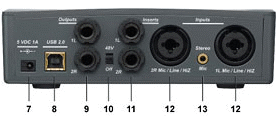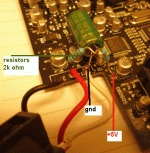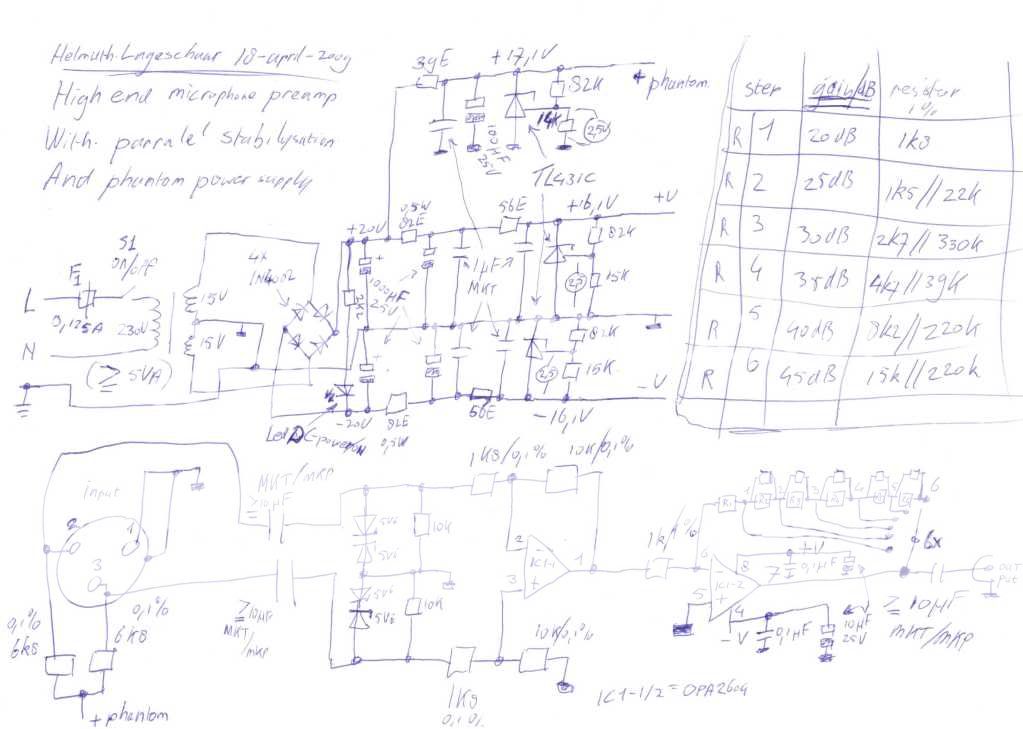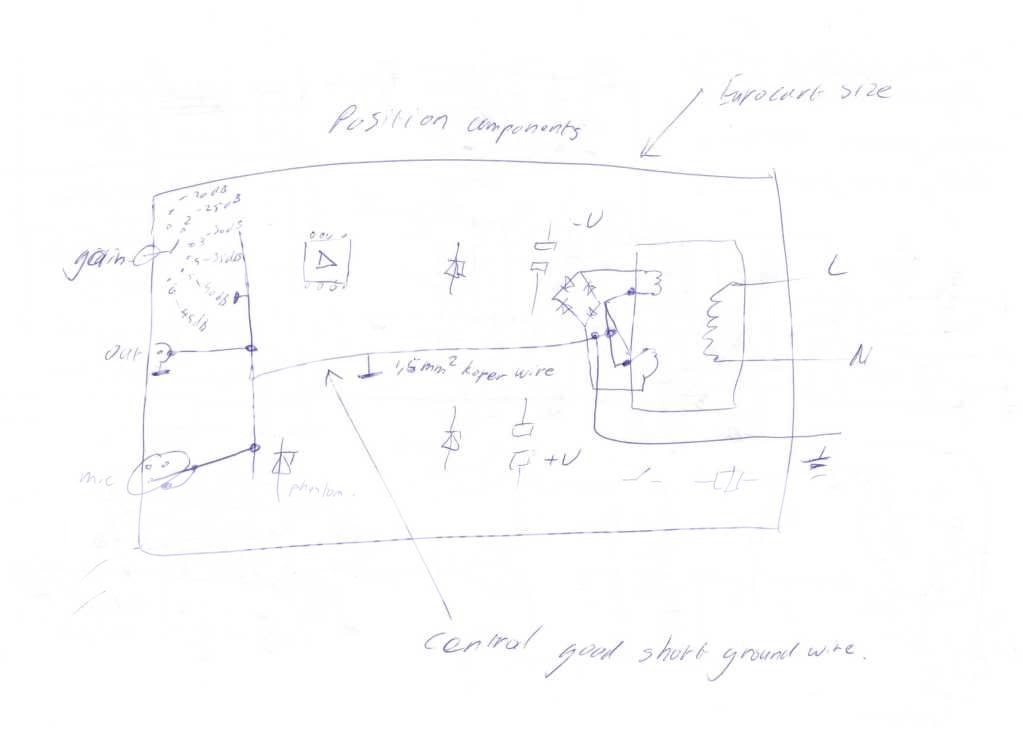Did you read my post? You don't need extras with the EMU Tracker Pre. Only input 13.
Well lookie that. I missed that, I guess.
Well I might try that out tomorrow with one of the other capsules that I soldered up to leads, just out of curiosity. I think I have it working fine for the moment, though, and the fact that I have it wired to a mono jack makes it a little simpler to do things like run the amp through a voltage divider cable straight into the other channel for a reference signal, etc. Thanks for the info, though!
I've been reading up on how to assemble a measurement microphone for use with a sound card and stumbled across this explanation.
While I cannot vouch for its accuracy, it does address some questions from this post.
Barry
While I cannot vouch for its accuracy, it does address some questions from this post.
Barry
What is the opinion on the Figure 6 pre-amp shown here?:
http://sound.westhost.com/project93.htm
It looks quite good.
I have a mixer with on-board mc input, but I think they could be quieter really. Also, it'd be nice not to go through all those busses and EQ's for a simple measurement system.
If I powered this from a 9v battery and connected it to my soundcard line-in, how would I get optimum levels? With the mixer I adjust the mic gain and observe the LED bargraph (which I match to the input level on the soundcard) to set the best level. With this, I can only adjust the level on the PC, which probably isn't best?
Also, I wouldn't be able to take advantage of the balanced output with my current soundcard, should I just leave off C6, R13, C8 and F2 altogether, and connect from pins 2 and 1?
Sorry for all the questions
http://sound.westhost.com/project93.htm
It looks quite good.
I have a mixer with on-board mc input, but I think they could be quieter really. Also, it'd be nice not to go through all those busses and EQ's for a simple measurement system.
If I powered this from a 9v battery and connected it to my soundcard line-in, how would I get optimum levels? With the mixer I adjust the mic gain and observe the LED bargraph (which I match to the input level on the soundcard) to set the best level. With this, I can only adjust the level on the PC, which probably isn't best?
Also, I wouldn't be able to take advantage of the balanced output with my current soundcard, should I just leave off C6, R13, C8 and F2 altogether, and connect from pins 2 and 1?
Sorry for all the questions

I recently did a small modification to ESI ESU22 soundcard.
http://www.thomann.de/gb/esi_esu_22.htm
This soundcard originally has a mic input for dynamic microphone, but by adding a 2k resistor - 50..100u cap to ground - 2k resistor to plus input of XLR connector one can nicely use an electret microphone.
(XLR -> RCA converter is also needed)
The plus of this card is that it has software controllable mic gain with dB accurate steps.
http://www.thomann.de/gb/esi_esu_22.htm
This soundcard originally has a mic input for dynamic microphone, but by adding a 2k resistor - 50..100u cap to ground - 2k resistor to plus input of XLR connector one can nicely use an electret microphone.
(XLR -> RCA converter is also needed)
The plus of this card is that it has software controllable mic gain with dB accurate steps.
Attachments
BarryV said:I've been reading up on how to assemble a measurement microphone for use with a sound card and stumbled across this explanation.
While I cannot vouch for its accuracy, it does address some questions from this post.
The Microphone input on most soundcards is very noisy. It works, but measurements can sometimes be suspect. It is much better to make/buy a preamp and use the line inputs.
Hi Ron E,
I think you guessed right, at least my ECM8000 sample doesn’t seem to be suffering from the proximity effect that I desribed in my earlier post #26. Since that time, I've managed to put together a pre-amp and made some measurements as shown attached.
Why Behringer publish a response like this is still not clear and they haven’t responded to my emails on this issue either.
I’ve made two sets of measurements, one that used a 3.5” driver on an OB of about 11” square. The second set of measurements used a 10” driver in a 2cf sealed enclosure.
For these tests, I used a calibrated microphone obtained through Liberty Instruments as a reference to compare with the ECM8000. The two microphones were taped together for these tests. Tests were then made at three different distances, <1cm, 10cm and 40cm from the loudspeakers.
The response of the Liberty Instruments microphone was then subtracted from the response of the ECM8000 to obtain the difference responses shown in the attachments. The 40cm responses were contaminated with noise at very low frequencies, which is especially true in the case of the 3.5” driver for obvious reasons, but I think it is reasonably clear that they still follow the responses of the NF and 10cm measurements. In the attached responses, I use the term NF (near-field) to define measurements made at <1cm.
So my conclusion is that the ECM8000 does not suffer from proximity effects and its response is about –3dB down compared with my Liberty Instruments reference microphone. I should also point out that the Liberty Instruments microphone has also been calibrated against a B&K 4135 microphone at low frequencies.
At some time in the future, I will run some tests to establish the ECM8000’s high frequency response and post a calibration file for my sample, but as others have advised earlier in this thread, having your microphone calibrated by a good calibration service is money well spent IMHO.
Peter
I think you guessed right, at least my ECM8000 sample doesn’t seem to be suffering from the proximity effect that I desribed in my earlier post #26. Since that time, I've managed to put together a pre-amp and made some measurements as shown attached.
Why Behringer publish a response like this is still not clear and they haven’t responded to my emails on this issue either.
I’ve made two sets of measurements, one that used a 3.5” driver on an OB of about 11” square. The second set of measurements used a 10” driver in a 2cf sealed enclosure.
For these tests, I used a calibrated microphone obtained through Liberty Instruments as a reference to compare with the ECM8000. The two microphones were taped together for these tests. Tests were then made at three different distances, <1cm, 10cm and 40cm from the loudspeakers.
The response of the Liberty Instruments microphone was then subtracted from the response of the ECM8000 to obtain the difference responses shown in the attachments. The 40cm responses were contaminated with noise at very low frequencies, which is especially true in the case of the 3.5” driver for obvious reasons, but I think it is reasonably clear that they still follow the responses of the NF and 10cm measurements. In the attached responses, I use the term NF (near-field) to define measurements made at <1cm.
So my conclusion is that the ECM8000 does not suffer from proximity effects and its response is about –3dB down compared with my Liberty Instruments reference microphone. I should also point out that the Liberty Instruments microphone has also been calibrated against a B&K 4135 microphone at low frequencies.
At some time in the future, I will run some tests to establish the ECM8000’s high frequency response and post a calibration file for my sample, but as others have advised earlier in this thread, having your microphone calibrated by a good calibration service is money well spent IMHO.
Peter
Attachments
Ron,
The trick of taping two microphones together will not work at high frequencies unless the two microphones have the same diameter at their faces. The reason being that they will act somewhat like baffles to each other (restricting the area each can radiate into) so the comparison will leave the smaller diameter microphone looking bumped up at high frequencies compared to the larger diameter microphone. If you subtract dBs, it will look like the larger diameter mic (the 1/2 inch faced Behringer) has more high frequency rolloff than actual. The effect can be a couple dB near 20kHz and above. Even if both mics use the same capsule, the diameters of the bodies that hold them will have a remarkably strong effect.
I only mention this because I've been burned by that approach!
The trick of taping two microphones together will not work at high frequencies unless the two microphones have the same diameter at their faces. The reason being that they will act somewhat like baffles to each other (restricting the area each can radiate into) so the comparison will leave the smaller diameter microphone looking bumped up at high frequencies compared to the larger diameter microphone. If you subtract dBs, it will look like the larger diameter mic (the 1/2 inch faced Behringer) has more high frequency rolloff than actual. The effect can be a couple dB near 20kHz and above. Even if both mics use the same capsule, the diameters of the bodies that hold them will have a remarkably strong effect.
I only mention this because I've been burned by that approach!
Measuring mics
....a look on this papers maybe helpful:
http://www.earthworksaudio.com/tech/ew_measures_mics.pdf
http://www.fesb.hr/~mateljan/arta/AppNotes/AP5_MikroMeasChamber-Rev03Eng.pdf
Regards
Heinrich
....a look on this papers maybe helpful:
http://www.earthworksaudio.com/tech/ew_measures_mics.pdf
http://www.fesb.hr/~mateljan/arta/AppNotes/AP5_MikroMeasChamber-Rev03Eng.pdf
Regards
Heinrich
Ok, I am now building my measurement mic from a Panasonic WM-61A capsule, basically because the free HOLMimpulse software recently released  . I have applied the Linkwitz mod (or on the capsule I found I had evidently already done it), so far as cutting the track goes.
. I have applied the Linkwitz mod (or on the capsule I found I had evidently already done it), so far as cutting the track goes.
After consideration, I am going to take advantage of my mixer unit for phantom power, adjustable mic pre-amp and LED bargraph. I'm not sure it's the greatest pre-amp, but should be fine for measurement. I have to hope the frequency response is flat with the EQ's set central and HPF switch out. I suppose I could loop it through the soundcard and run a test signal to calibrate out any effect it might be having? I'd need to add that calibration to the capsule's one though.
Here is the circuit I'm going to use, I have used this before:
http://mp3forkidz.com/mic/phantxy.html
The main difference is this mic is on a brass wand that I bought, rather expensive too! I think I have a small diecast box for the electronics too.
If anyone spots anything that might be wrong with this idea then let me know! The filter frequency I trust will be very low (filter formed by 1uF and 100k?). I'm going to breadboard it now.
PS: The transistors will be 2N3906 as that's all I can get, they have worked in the past fine
After consideration, I am going to take advantage of my mixer unit for phantom power, adjustable mic pre-amp and LED bargraph. I'm not sure it's the greatest pre-amp, but should be fine for measurement. I have to hope the frequency response is flat with the EQ's set central and HPF switch out. I suppose I could loop it through the soundcard and run a test signal to calibrate out any effect it might be having? I'd need to add that calibration to the capsule's one though.
Here is the circuit I'm going to use, I have used this before:
http://mp3forkidz.com/mic/phantxy.html
The main difference is this mic is on a brass wand that I bought, rather expensive too! I think I have a small diecast box for the electronics too.
If anyone spots anything that might be wrong with this idea then let me know! The filter frequency I trust will be very low (filter formed by 1uF and 100k?). I'm going to breadboard it now.
PS: The transistors will be 2N3906 as that's all I can get, they have worked in the past fine
I hope my construction isn't too off topic! After testing the breadboarded circuit successfully I am building the actual unit now. What I have left to do is mount the brass wand (with the capsule at the tip), to the box. Also, I need to mount the capsule to the wand with electrical conduction for the ground! I haven't figured this out yet, conductive epoxy would be ideal but very expensive 

An externally hosted image should be here but it was not working when we last tested it.
An externally hosted image should be here but it was not working when we last tested it.
This is the circuit I use for Panasonic WM-60 and WM-61 microphones. Press the mic capsule into a plastic toilet water supply tube and you have an inexpensive boom microphone. Put the mic capsule in one end and feed the wires out the other. You can get this tube at any hardware store.
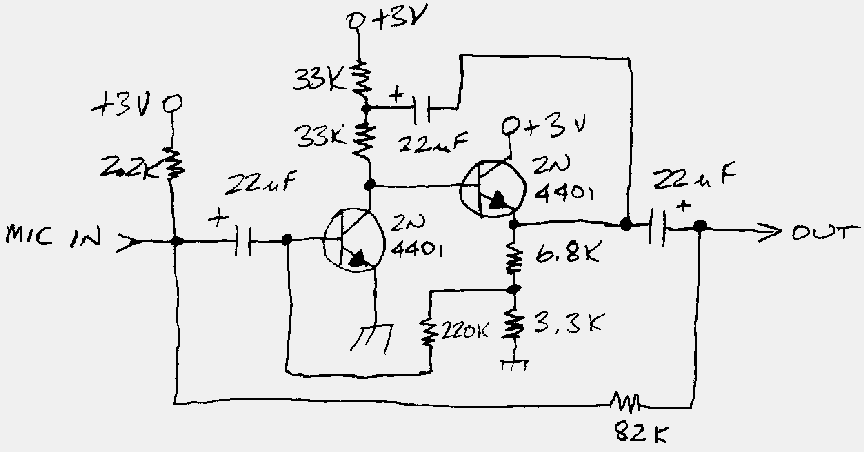

Same here in South Africa. I ended up buying a calibrated mic from Cross-Spectrum labs, and selling my old ECM8000 to a local DIYer.
See also the calibration report.
Calibration can be done down to 5Hz on request.
I also just bought the ECM8000 from Cross Spectrum to have for portable use. I was a bit concerned about the absolute sensitivity being dependent on loading; both from the preamp and phantom power resistors, however they confirmed that the measured output impedance was about 100-150 ohms. Their pre-amp is >40K so essentially open circuit, and they apply the full 48V when testing.
Mentioning it here to have the info where I won't lose it and in case it is of value to others.
He was not sure if it was true balanced - anyone know?
Also forgot to ask if it works as well with say 12-20V phantom power - anyone?
Pete B.
I also just bought the ECM8000 from Cross Spectrum to have for portable use. I was a bit concerned about the absolute sensitivity being dependent on loading; both from the preamp and phantom power resistors, however they confirmed that the measured output impedance was about 100-150 ohms. Their pre-amp is >40K so essentially open circuit, and they apply the full 48V when testing.
Mentioning it here to have the info where I won't lose it and in case it is of value to others.
He was not sure if it was true balanced - anyone know?
Also forgot to ask if it works as well with say 12-20V phantom power - anyone?
Pete B.
I think that it takes more phantom voltage. Or at lest I tried it with a DBX DriveRack PA and it didn't work.
I think that it takes more phantom voltage. Or at lest I tried it with a DBX DriveRack PA and it didn't work.
Just noticed rated for 15-48V right in the Behringer spec; question is if the sensitivity changes much.
- Status
- This old topic is closed. If you want to reopen this topic, contact a moderator using the "Report Post" button.
- Home
- Loudspeakers
- Multi-Way
- DIY measurement mic
